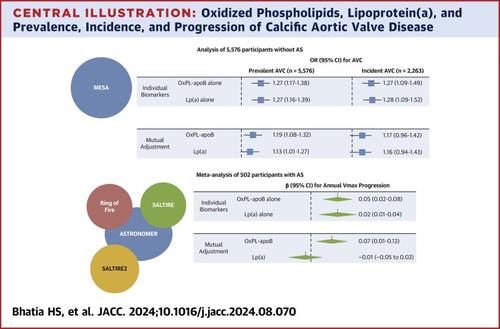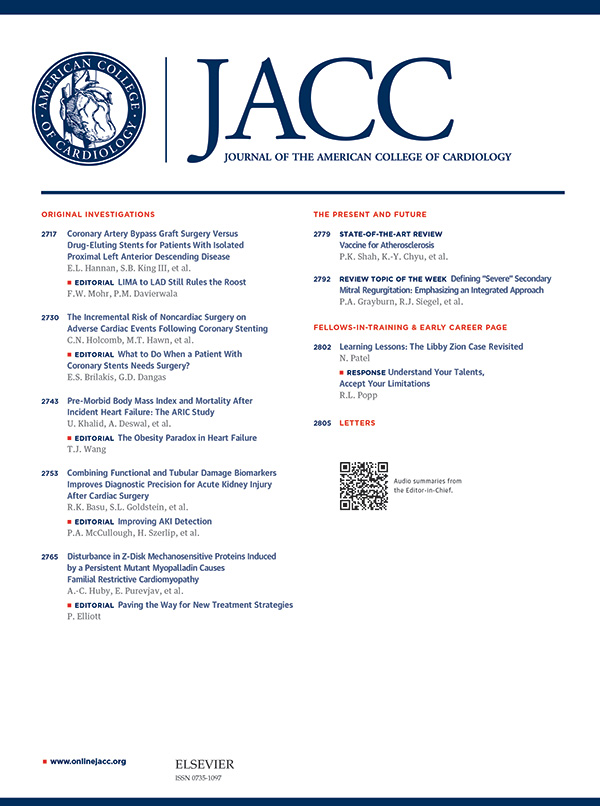氧化磷脂与钙化性主动脉瓣膜疾病
IF 21.7
1区 医学
Q1 CARDIAC & CARDIOVASCULAR SYSTEMS
引用次数: 0
摘要
背景氧化磷脂(OxPL)由含载脂蛋白B-100的脂蛋白(OxPL-apoB)包括脂蛋白(a)(Lp[a])携带。本研究旨在评估 OxPL-apoB、脂蛋白(a)与钙化性主动脉瓣疾病(CAVD)之间的关系。方法在 MESA(多种族动脉粥样硬化研究)中评估了 OxPL-apoB 和脂蛋白(a),并对 4 项针对主动脉瓣狭窄(AS)患者的随机试验进行了参与者水平的荟萃分析。在 MESA 中,使用多变量序数回归模型评估了 OxPL-apoB 和 Lp(a) 与基线和 9.5 年主动脉瓣钙(AVC)的关系。在荟萃分析中,使用多变量线性回归模型评估了 OxPL-apoB 和 Lp(a) 与 AS 进展(主动脉瓣喷射速度峰值的年化变化)之间的关系。结果在 MESA 中,OxPL-apoB 和 Lp(a) 均与 AVC 的流行有关(每 SD OR 分别为 1.19 [95% CI: 1.07-1.32] 和 1.13 [95% CI: 1.01-1.27]),两者之间存在显著的交互作用(P < 0.01)。单独评估时,OxPL-apoB 和 Lp(a) 均与 9.5 年后发生的急性心肌梗死相关(交互作用 P < 0.01)。OxPL-apoB∗Lp(a)交互作用表明,随着 Lp(a)水平的增加,OxPL-apoB 的患病率和发生 AVC 的几率更高。在荟萃分析中,当单独分析时,OxPL-apoB 和 Lp(a)都与主动脉瓣喷射峰值速度的快速增加有关,但当同时评估时,只有 OxPL-apoB 仍然显著(ß:0.07;95% CI:0.01-0.12)。本文章由计算机程序翻译,如有差异,请以英文原文为准。

Oxidized Phospholipids and Calcific Aortic Valvular Disease
Background
Oxidized phospholipids (OxPLs) are carried by apolipoprotein B-100–containing lipoproteins (OxPL-apoB) including lipoprotein(a) (Lp[a]). Both OxPL-apoB and Lp(a) have been associated with calcific aortic valve disease (CAVD).
Objectives
This study aimed to evaluate the associations between OxPL-apoB, Lp(a) and the prevalence, incidence, and progression of CAVD.
Methods
OxPL-apoB and Lp(a) were evaluated in MESA (Multi-Ethnic Study of Atherosclerosis) and a participant-level meta-analysis of 4 randomized trials of participants with established aortic stenosis (AS). In MESA, the association of OxPL-apoB and Lp(a) with aortic valve calcium (AVC) at baseline and 9.5 years was evaluated using multivariable ordinal regression models. In the meta-analysis, the association between OxPL-apoB and Lp(a) with AS progression (annualized change in peak aortic valve jet velocity) was evaluated using multivariable linear regression models.
Results
In MESA, both OxPL-apoB and Lp(a) were associated with prevalent AVC (OR per SD: 1.19 [95% CI: 1.07-1.32] and 1.13 [95% CI: 1.01-1.27], respectively) with a significant interaction between the two (P < 0.01). Both OxPL-apoB and Lp(a) were associated with incident AVC at 9.5 years when evaluated individually (interaction P < 0.01). The OxPL-apoB∗Lp(a) interaction demonstrated higher odds of prevalent and incident AVC for OxPL-apoB with increasing Lp(a) levels. In the meta-analysis, when analyzed separately, both OxPL-apoB and Lp(a) were associated with faster increase in peak aortic valve jet velocity, but when evaluated together, only OxPL-apoB remained significant (ß: 0.07; 95% CI: 0.01-0.12).
Conclusions
OxPL-apoB is a predictor of the presence, incidence, and progression of AVC and established AS, particularly in the setting of elevated Lp(a) levels, and may represent a novel therapeutic target for CAVD.
求助全文
通过发布文献求助,成功后即可免费获取论文全文。
去求助
来源期刊
CiteScore
42.70
自引率
3.30%
发文量
5097
审稿时长
2-4 weeks
期刊介绍:
The Journal of the American College of Cardiology (JACC) publishes peer-reviewed articles highlighting all aspects of cardiovascular disease, including original clinical studies, experimental investigations with clear clinical relevance, state-of-the-art papers and viewpoints.
Content Profile:
-Original Investigations
-JACC State-of-the-Art Reviews
-JACC Review Topics of the Week
-Guidelines & Clinical Documents
-JACC Guideline Comparisons
-JACC Scientific Expert Panels
-Cardiovascular Medicine & Society
-Editorial Comments (accompanying every Original Investigation)
-Research Letters
-Fellows-in-Training/Early Career Professional Pages
-Editor’s Pages from the Editor-in-Chief or other invited thought leaders

 求助内容:
求助内容: 应助结果提醒方式:
应助结果提醒方式:


